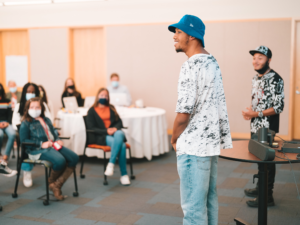Equipping Young Leaders to Take on the 32 Most Important Issues of Our Time

As a species, we’ve made a good deal of progress and teed up some world-changing opportunities. But we’ve also created a pile of problems that young people will inherit. We owe them a chance to explore what they’re in for and a head start on making a difference.
The UN General Assembly adopted the 2030 Agenda for Sustainable Development. A subsequent campaign resulted in 17 Global Goals that provide a roadmap for a better future.
Global Goals are a good start, but most are pressing problems that don’t fully reflect impact opportunities and emerging issues. To the Global Goals we added eight goals inspired by the Gates Foundation sponsored Grand Challenges and the National Academy of Engineering Grand Challenges, and another eight (#1-6, #8, #27) that reflect equipped human beings making the world better for others.
Consider these 32 draft goals our attempt to identify the issues that matter most (and please comment if you have an edit or addition).
1. Extend Dignity and Equity: Dignity is an inherent part of the human condition. Gender inequalities limit advancement for all in societies around the world. Addressing these inequities improves girl’s empowerment, child health, nutrition, wage equity and financial services. Thoughtful support for immigrant communities is another urgent need. Emerging issues around human identity, consciousness and life with smart machines will raise new dignity demands.
2. Improve Impact Strategies: There is a big opportunity to build and share strategies and tools that improve life on earth. These attack skills for the new economy include design thinking, data wrangling, project management, collective impact partnerships and impact investing (we call the new impact formula Cause+Code). Providing access to open data and machine-learning tools.
3. Improve Lives Through Enterprise and Innovation: As traditional jobs become a smaller part of the employment landscape, teaching creativity, entrepreneurship and innovation as value creation grows in importance. Learning how to pitch, secure and deliver on customer engagements is a new basic skill. Learning how to take an idea through a set of iterations to scaled impact is the new master’s degree.
4. Extend Fitness and Longevity: Promoting healthy living, diet and exercise and longevity; strategies and incentives for human behavior change.
5. Develop Mindfulness and Character: Promoting purposeful action, social awareness and habits of success. KnowledgeWorks Foundation notes three core skills as the new foundation for readiness: deep self-knowledge, emotional regulation, empathy and perspective taking.
6. Promote Cultural Competence: Developing world language proficiency and cultural competence.
7. Quality Lifelong Learning: Ensure inclusive and equitable quality education and promote lifelong learning opportunities for all. New opportunities include comprehensive learner profiles, next generation learning models and platforms.
8. Powerful Expressions: Extending the quality of and access to human expression, visual and performing arts.
9. End Hunger: Boost agricultural productivity, achieve food security and improved nutrition and promote sustainable agriculture (see #26).
10. Eradicate Poverty: By 2030, reduce at least by half the proportion of men, women and children of all ages living in poverty. The key will be equipping more people for high contribution tasks, improving access to resources, and providing a living wage for those in low-skill services.
11. Healthy Growth and Early Learning: Pregnancy and the first 1,000 days of life are a critical window of growth and brain development.
12. Better Information for Global Health: A systematic approach to collecting and managing health information can enhance medical care and public health response effectiveness. For individuals, precision medicine will identify genetically-based drivers of disease in order to develop new, more effective treatments.
13. Innovations and Interventions for Global Health: Epidemics get all the news coverage, but in 2015 there were about 214 million cases of malaria and 438,000 malaria deaths. Morbidity is down 60% since 2000 but the disease burden in places like Sub-Saharan Africa remains enormous. Innovations in vaccines, therapeutics and diagnostics have the potential to be translated into safe, effective, affordable and widely utilized interventions to protect against the acquisition, progression or transmission of infectious diseases, or to provide a cure for infectious diseases.
While a cure for cancer is unlikely in the near term, it is likely that environmental, behavioral and diagnostic routines can reduce morbidity substantially.
14. Understanding The Brain: After decades of research, the brain remains largely a mystery. Reverse-engineering the brain could have multiple impacts that go far beyond artificial intelligence and will promise great advances in healthcare, manufacturing, and communication.
15. Consider Human Augmentation: The big emerging policy question is the increasing ability to predict genetic features and even conduct genetic enhancements. Now that we can alter the code of life, how will we use it? Pharmacology and augmented and virtual reality pose additional ethical questions.
16. Support Human Thriving: The automation economy will continue to produce waves of dislocation and growing inequality. Thriving communities need a thick web of youth, family and employment services. Combining and coordinating public and private sources and services requires civic knowledge, impact-focused personal leadership and collective impact strategies (see #2)
17. Climate Action: Take urgent action to combat climate change and its impacts. The planet is warming, sea levels are rising and weather events are becoming more unpredictable. This appears to be a largely man-made phenomenon and one that, if we act quickly, we may be at least partially mitigate. Carbon sequestration may be part of the mix.
18. Affordable and Clean Energy: Ensure access to affordable, reliable, sustainable and clean energy for all. Currently, solar energy provides less than 1% of the world’s total energy, but it has the potential to provide much more. Safe fusion may be part of the energy future.
19. Sustainable Economic Growth: Promote sustained, inclusive and sustainable economic growth, full and productive employment and decent work for all.
20. Robust Public and Commercial Infrastructure: Build resilient infrastructure, promote inclusive and sustainable industrialization and foster innovation. As the majority of the world’s population crowds into 50 megacities, it poses particular infrastructure challenges, especially in Asia. “America’s infrastructure, along with those of many other countries, is aging and failing, and that funding has been insufficient to repair and replace it,” according to the National Academy. Reliable and affordable public transportation is key to sustainable development.
21. Sustainable Cities and Habitats: Make cities and human settlements inclusive, safe, resilient and sustainable. Ensure sustainable consumption and production patterns. During our three-year Smart Cities investigation, we found a community of scientists, sociologists and technologists committed to livable, workable and sustainable cities (check out #SmartCities).
22. Clean Water and Sanitation: Ensure availability and sustainable management of water and sanitation for all. About one out of every six people living today do not have adequate access to water, and more than double that number lack basic sanitation, for which water is needed.
23. Life Below Water: Conserve and sustainably use the oceans, seas and marine resources for sustainable development.
24. Life On Land: Protect, restore and promote sustainable use of terrestrial ecosystems, sustainably manage forests, combat desertification, and halt and reverse land degradation and halt biodiversity loss.
25. Justice and Strong Institutions: Promote peaceful and inclusive societies for sustainable development, provide access to justice for all and build effective, accountable and inclusive institutions at all levels.
26. Sustainable Agriculture: Restore the nitrogen cycle and mitigate agricultural disruption while limiting effects on people living in poverty. Develop AgTech to boost productivity and reduce impact.
27. Beautiful Shared Places: Social and cultural infrastructure. Art and architecture. Shared beautiful spaces, open spaces, parks and museums.
28. Peace and Security: Mitigate existential threats of nuclear accidents and terrorist activity as well as natural disasters.
29. Safe and Constructive Use of Artificial Intelligence: Narrow artificial intelligence is what powers chatbots on Facebook, reads x-rays, recommends music and beat the best Go player in the world. At some point in the next few decades smart AI will challenge human intelligence. In the interim, AI and automation will result in waves of job loss, growing inequality, and numerous social challenges. Leveraging the benefits and mitigating the challenges of AI may be the central challenge of the coming decades.
30. Privacy and Cybersecurity: Personal and collective safety, privacy and security. Physical attacks associated with terrorism will continue but pale in comparison to the economic risks associated with cybersecurity breaches in public data systems, transportation routing systems and power grids. The National Academy said, “It is clear that engineering needs to develop innovations for addressing a long list of cybersecurity priorities.” Bioterrorism and rogue nukes are a related threat, and will almost certainly involve a cybersecurity problem.
31. Accelerate Discovery: Support and accelerate scientific discovery, apply data tools, discovery tools and (increasingly) tools to automate discovery. Engineers will continue to be partners with scientists in the great quest for understanding many unanswered questions of nature.
32. Space and Extraplanetary Life: Exploration of space and the potential for life on other planets.
Time To Sweat The Big Stuff (Not The Small Stuff)
If we take citizenship preparation seriously, we should be encouraging young people to engage with the world’s most important issues by helping them frame projects around these goals. Here are six reasons:
- Extended and integrated challenges are the best way to promote deeper learning and develop readiness for the automation economy.
- The goals include interesting and timely causes that many young people will find motivating.
- Making a contribution toward a goal they care about may be the best way to develop student agency.
- Goal focused projects get kids into the community and connected with local resources (see #PlaceBasedEd)
- It’s also a chance to shift the paradigm from “prepare for a career 10 years from now” to “make a difference right here, right now.”
- Taking on real challenges will promote creative and effective uses of technology from collaboration to production.
If you want a content-rich and a relevant and applied course of study, the 32 Goals are a good starting point. However, most of these goals don’t fit neatly into the master schedule and they are not on anyone’s test. So where and how could a school, district or network incorporate these goals?
- Integrate projects into existing courses. The Global Goals site has useful project resources for 16 of these goals.
- Plan an integrated unit between two courses. Most of the goals combine science, sociology, research, problem-solving and writing.
- Capstone projects in the last two years of high school are a good place to start. Each academy at Reynoldsburg High School in Ohio and Chavez Schools in Washington, D.C., engage in a capstone project. Students at Singapore American School are required to conduct a capstone project.
If you’re serious about helping young people change the world, you could go wall-to-wall PBL. The mission of the Workshop School in Philadelphia is to “unleash the creative and intellectual potential of young people to solve the world’s toughest problems.” They put real-world problems at the center of the curriculum and evaluate student work based on how well they define, explore, and develop solutions to those problems.
Networks of project-based high schools (High Tech High, New Tech Network, Big Picture, Envisions, Edvisions) help students develop a series of applied and integrated projects that lead to the development of valuable knowledge and skills.
If high school students worked on the first eight goals (which are about skill building and teaching) every year and had the opportunity to go deep on one goal each semester, they’d get through half of this list in four years–a pretty good sampling of the world’s most pressing issues.
Cycling through the Global Goals could provide an interesting and applied approach to physical and life science. Thoughtful prompts that link Goals to the exploration of historical cause and effect could be an interesting and applied approach to history.
A low-risk approach would be for a big high school to launch an upper division academy (a microschool with two teachers and 40 students) that, over the course of two years, would allow students the opportunity to address many of the goals through projects.
Local to Global
“If we really want to develop creators, thinkers and innovators in the next generation of learners, let’s design high school programs that focus on The Global Goals,” said Nate McClennen, Vice President for Education and Innovation at Teton Science Schools. “Using place-based education to engage students locally around these goals will both strengthen communities and develop learner capacity to address global challenges and opportunities.”
To engage millions of students in local projects connected to global goals, it would be helpful to have:
- More content associated with each goal (GlobalGoals.org is a start);
- Templates for local projects;
- A microcredential system that could help pack projects full of valuable learning (i.e, science, math, communication and collaboration);
- Access to data sources, data tools and project tools (mentors would be really helpful); and
- A project gallery for completed contributions.
Community leadership development groups could use the same template of local action. For example, global background on Human Thriving would illustrate the importance of safety nets (#16); local framing would list local youth and family services and demographic data would help identify service gaps. A project might be investigating the potential for a new family support service.
Why not make Global Goals central to the high school and college course of study? We might just improve our chances of reducing poverty, combating climate change and fighting inequality.
This post builds on a May 2016 post, Earth Owner’s Manual: 17 Things Young Adults Should be Studying.
For more, see:
- Preparing Students for a Project-Based World
- Improving Learner Experience: Agency, Community, Challenge
- Project-Based Pittsburgh: Thinking Beyond Schools to Remake Learning
Stay in-the-know with all things EdTech and innovations in learning by signing up to receive the weekly Smart Update.







Tom Vander Ark
Seth Godin posted a list of 23 problems worth solving https://seths.blog/2018/12/hilberts-list/